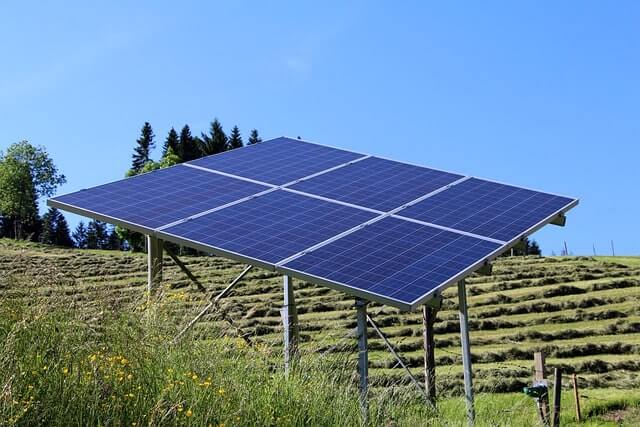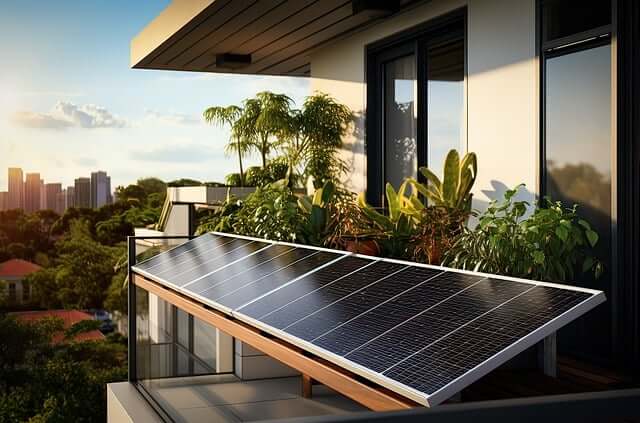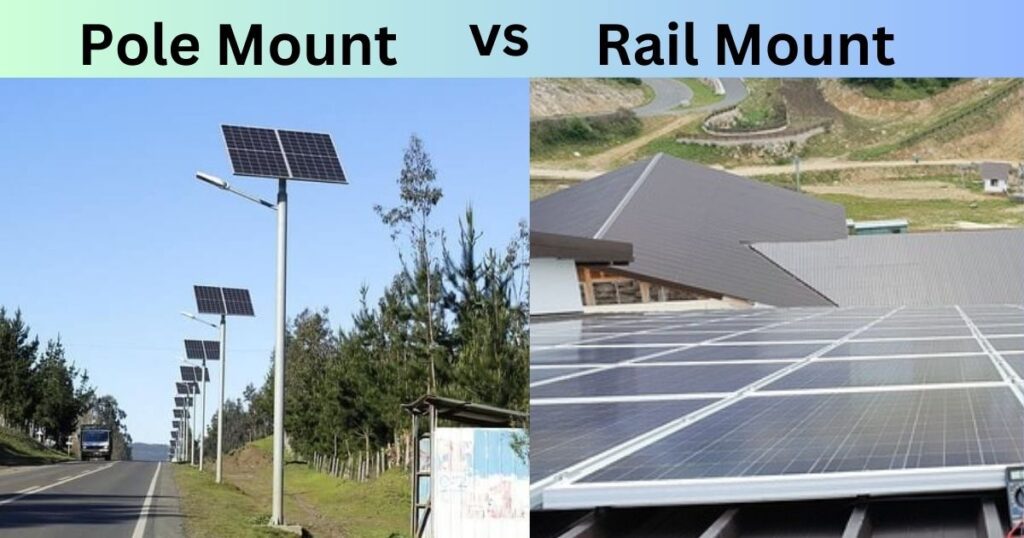Last updated on May 17th, 2024 at 04:51 am
When faced with the choice between pole mount vs rail mount solar panel installation, we find ourselves in a delightful dilemma, with each option carrying its unique allure, leaving us wondering which path will lead to harnessing maximum solar power. As we stand at this crossroads, ready to embark on our solar journey, pondering the benefits and limitations of both systems becomes inevitable.
In this article, we will delve into the intriguing choice between rail mount vs. pole mount solar panel installation, providing you with the insights you need to make an informed decision. Whether we choose the adaptability and terrain freedom of pole mount systems or the seamless rooftop integration and accessibility of rail mount systems, the ultimate goal remains the same—to harness the abundant power of the sun and contribute to a greener, more sustainable future.
What is a pole-mounted solar panel?
Pole mount solar panels refer to a type of solar photovoltaic installation where solar panels are securely mounted on top of sturdy poles that are anchored into the ground. This installation method allows solar panels to be elevated above the surface, typically the ground, enabling them to capture sunlight effectively and convert it into electricity.
Pole mount solar panels are designed to overcome challenges presented by uneven terrain, limited available space, or when rooftop installations are not feasible. By utilizing poles as a mounting structure, solar panels can be strategically positioned to optimize sun exposure throughout the day, thereby increasing their energy production potential.

Why go for pole mount?
You might be wondering, “Why should I choose pole-mount solar panels over the traditional rooftop setup?” Well, here are some fantastic reasons:
Terrain Freedom
Ever looked at that slightly sloping backyard or that bumpy hillside and thought, “I wish I could install solar panels there”? Well, with pole-mount solar panels, you absolutely can! These solar wonders offer the ultimate terrain freedom.
Unlike rooftop installations that demand a flat surface, pole mounts embrace the natural lay of the land. Whether it’s a gentle slope or a rolling hill, these solar setups will anchor securely into the ground, making the most of every inch of your property.
Adjustable Tilt Angles for Optimal Sun Exposure
When installing pole mount solar panels, the solar array is typically mounted on top of sturdy poles, as the name suggests. The panels are fixed in place on the poles, but their tilt angle can be manually adjusted. This means that during the installation process or whenever necessary, you can change the tilt angle of the solar panels to align them more effectively with the sun’s position in the sky.
For example, in the morning, you can tilt the panels slightly to the east to capture the early morning sunlight. As the day progresses and the sun rises higher in the sky, you can adjust the tilt angle to be more perpendicular to the sun’s rays, optimizing the energy capture during the peak sun hours.
Ideal for Remote Locations
Are you living off-grid or have a remote cabin in the wilderness? Pole-mount solar panels are like self-sufficient power plants that thrive in even the most secluded corners of the Earth. They don’t need an existing building to latch onto; they’ll stand tall and strong on their own, generating renewable energy to power your off-grid adventures.
Easy Maintenance
Maintaining pole-mount solar panels is straightforward and hassle-free. Unlike rooftop panels that may require climbing onto the roof for cleaning and maintenance, pole mount systems are easily accessible at ground level.
This accessibility makes it simpler for users or technicians to clean the panels periodically and inspect their performance. Easy maintenance ensures that the solar panels continue to operate efficiently, extending the lifespan of the system and optimizing energy production.
Limitations of pole-mounted solar panels
Land Usage
Pole-mount solar panels require additional land compared to rooftop installations. The poles and the space between arrays can take up valuable real estate, which may be a limitation for properties with limited available space.
Installation Costs
The installation of pole-mount solar panels can be more expensive than rooftop installations. The process involves digging holes for the poles, securing them, and then mounting the solar panels. These additional materials and labor costs can impact the overall project budget.
Wind Loading and Stability
Pole-mount solar panels are exposed to different wind forces compared to rooftop installations. In areas with strong winds or severe weather conditions, the structural stability of the poles and the panels’ mounting system becomes crucial. Adequate engineering and reinforcement are essential to ensure the system can withstand adverse weather events.
Snow Accumulation
In regions with heavy snowfall, pole-mount solar panels might be more susceptible to snow accumulation compared to rooftop installations. Proper tilt angles and regular snow removal may be necessary to maintain optimal performance during winter months.
What is a rail-mounted solar panel?
Rail-mounted solar panels refer to a type of solar panel installation where the solar panels are attached to horizontal rails that are securely fixed to a surface, such as a rooftop or a ground-mounted frame. The rails serve as the mounting structure, and the solar panels are fastened to the rails using clamps or other mounting hardware.

Why go for rail mount?
Versatile Design
Rail mount solar panels are highly versatile in system design and configuration. The horizontal mounting rails allow for various layouts, enabling solar installers to optimize the placement of solar panels based on the available space and energy needs. This flexibility ensures that the solar system is tailor-made to fit the unique characteristics of each rooftop or ground-mounted area, maximizing energy generation potential.
Easy Rooftop Integration
Rail mount solar panels are designed to integrate seamlessly with rooftops. The mounting rails provide a secure foundation for the solar panels without compromising the structural integrity of the building. The even distribution of weight ensures that the solar array sits comfortably on the rooftop, reducing the risk of any damage or added strain on the structure.
Cost-Effective Installation
Rail mount solar panels offer a cost-effective installation process. The simplicity of the rail-based system streamlines the installation, reducing labor time and associated costs. Additionally, the ease of installation makes rail-mount solar panels accessible to a wider range of homeowners and businesses, making solar energy more financially viable and appealing.
Expandable Capacity
Rail mount solar panels offer the advantage of expandable capacity. As your energy needs grow or if you wish to increase your solar power output, additional solar panels can be seamlessly added to the existing rail system. This expandable feature makes rail mount installations a future-proof solution, accommodating changes in energy demands and allowing homeowners and businesses to scale their solar systems as needed.
Limitations of roof-mounted solar panels
Rooftop Space Requirement
Rail-mount solar panels require sufficient rooftop space for installation. If the available roof area is limited or already occupied by other structures, it may be challenging to accommodate the solar array, reducing the overall capacity of the system.
Potential Roof Penetrations
The installation of rail-mount solar panels may require roof penetrations to attach the mounting hardware securely. While these penetrations are typically sealed and well-protected, some homeowners may have concerns about potential roof leaks or long-term roof maintenance.
Limited Ground Use
While rail mount systems are primarily designed for rooftop installations, they may not be as practical for ground-mounted solar projects. Ground-mounted setups often require different mounting solutions to optimize space usage and solar panel angles.
Dependence on Roof Orientation
The efficiency of rail-mount solar panels is dependent on the roof’s orientation and tilt angle. If a rooftop does not have optimal exposure or is shaded for significant portions of the day, the solar system’s energy generation may be negatively impacted.
Application scenarios
Recommended Applications for Pole Mount
Off-Grid Installations in Remote Areas
Picture a secluded cabin nestled deep within the wilderness, far away from the hustle and bustle of city life. Now, imagine powering that serene oasis with clean, renewable energy. That’s where pole-mount solar panels shine! In off-grid locations where access to traditional electricity grids is limited or nonexistent, pole mount systems come to the rescue.
With their ability to thrive in remote areas, these solar wonders harness abundant sunlight and convert it into much-needed electricity. Whether it’s a remote cabin, an agricultural site, or an eco-friendly research station, pole-mount solar panels provide a reliable source of power, giving you the freedom to embrace sustainable living wherever your adventurous spirit takes you!
Locations with Uneven Terrain or Limited Available Land
Life isn’t always a perfectly flat canvas, and neither is the land we live on. In areas where the ground isn’t as smooth as a tabletop, pole-mount solar panels truly shine. Traditional rooftop installations might struggle on uneven terrains, but pole mount systems rise to the occasion! They gracefully embrace slopes, hillsides, and bumpy landscapes, converting them into vibrant solar energy hubs.
Moreover, if you have limited available land but still dream of harnessing solar power, pole mount systems have got you covered. These solar pioneers make the most of every inch, showing that even the most challenging landscapes can be transformed into a green energy paradise!
Recommended Applications for Rail Mount
Residential and Commercial Rooftop Installations
Imagine your rooftop as a blank canvas, ready to be painted with a brushstroke of solar panels, powering your home or business with the sun’s abundant energy. Rail mount solar panels are the ideal brush for this artistic endeavor! These versatile systems are perfect for residential and commercial rooftop installations.
With their user-friendly design and seamless integration, they sit comfortably atop rooftops, capturing sunlight efficiently without disrupting your daily life. For homeowners looking to reduce electricity bills or businesses striving to embrace sustainable practices, rail mount solar panels offer an aesthetically pleasing and cost-effective solution, turning rooftops into eco-friendly powerhouses!
Areas with Ample Roof Space and Favorable Conditions
Some rooftops are like a stage, ready to host a solar energy extravaganza! If your property boasts ample roof space and enjoys favorable sun exposure, rail-mount solar panels are the shining stars of your solar performance. These solar wonders utilize the wide expanse of rooftop real estate, allowing for the optimal placement of solar panels.
They make the most of the favorable conditions, ensuring a bountiful harvest of solar energy throughout the day. So, whether it’s a sunny suburban home, a thriving commercial building, or a bustling industrial facility, rail-mount solar panels bring the gift of clean, green power to every corner of the rooftop.
Closing thoughts!
In conclusion, when it comes to choosing between pole-mount and rail-mount solar panels, I think it all comes down to your unique needs and the landscape of your property. If you’re living off-grid or have a remote cabin in the wilderness, I believe pole mount panels are like little power plants that can thrive in even the most remote corners of the Earth. They offer the freedom to embrace solar energy wherever your adventures take you.
On the other hand, if you’re looking to harness solar power on your rooftop or have ample roof space with favorable conditions, I think rail-mount solar panels are the perfect match. They seamlessly integrate with rooftops, providing an aesthetically pleasing and cost-effective solution for residential and commercial installations.
Both pole mount and rail mount systems have their strengths, and I believe it’s crucial to consider factors such as terrain, available space, and energy requirements.

